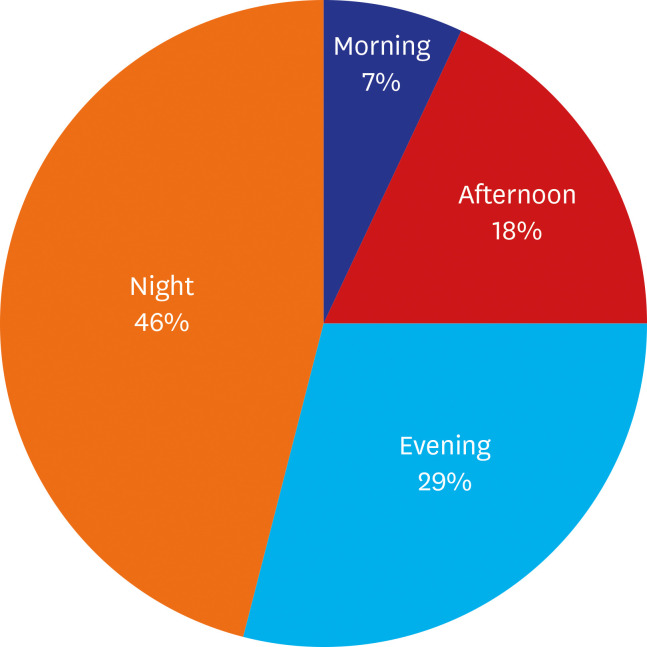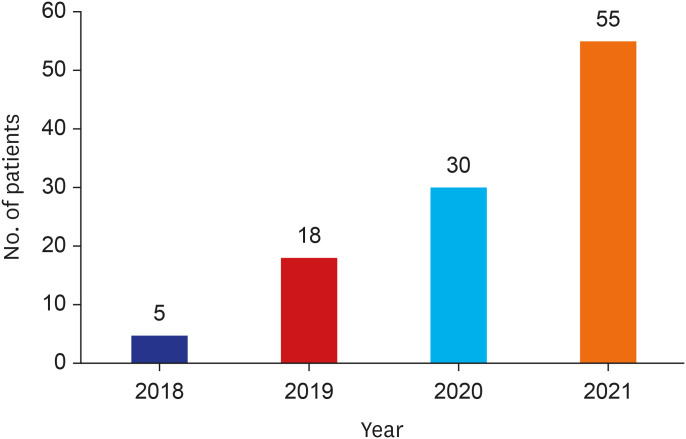J Korean Med Sci.
2022 Jun;37(22):e181. 10.3346/jkms.2022.37.e181.
Electric Scooter-Related Trauma in Korea
- Affiliations
-
- 1Department of Plastic and Reconstructive Surgery, Chonnam National University Hospital, Chonnam National University Medical School, Gwangju, Korea
- KMID: 2530420
- DOI: http://doi.org/10.3346/jkms.2022.37.e181
Abstract
- Background
The number of users of electric scooters, which provide swift and convenient mobility options, has increased sharply over recent years as their distribution as a shared service has expanded. Although the number of accidents and related damage has increased accordingly, limited research has analyzed data on the new types of accidents arising from electric scooters. This study aimed to analyze data on trauma characteristics due to accidents that occurred during electric scooter use.
Methods
A retrospective chart review was conducted for patients who visited the regional trauma center of our institute due to electric scooter accidents from April 2018 to October 2021. Information was extracted on helmet-wearing status, sex, age, drinking status, accident timeframe, accident mechanism, electric scooter proficiency (period of use), injury severity, severe trauma, lethality, admission to the intensive care unit, surgery under general anesthesia, and the trauma region.
Results
Among the 108 patients involved in electric scooter accidents, 92 patients were not wearing a helmet. Eighty-nine patients (85.2%) were male. The average age of the patients without a helmet was 31.3 years, while that of patients with a helmet was 34.1 years. The most frequent causes of accidents were lack of electric scooter operation experience and falling off the scooter due to obstacles (90 cases). Whether surgery was performed under general anesthesia was not associated with helmet use or non-use, although all patients who underwent facial fracture surgery were not wearing a helmet.
Conclusion
The craniofacial region was most frequently affected in electric scooter accidents and wearing a helmet was the best way to prevent craniofacial trauma. Although helmetwearing is mandatory, the majority of treated patients were not wearing a helmet at the time of injury. Thus, there is an urgent need to introduce a helmet rental system, as well as strict legal requirements, to improve this situation.
Figure
Reference
-
1. Trivedi TK, Liu C, Antonio AL, Wheaton N, Kreger V, Yap A, et al. Injuries associated with standing electric scooter use. JAMA Netw Open. 2019; 2(1):e187381. PMID: 30681711.2. Alwani M, Jones AJ, Sandelski M, Bandali E, Lancaster B, Sim MW, et al. Facing facts: Facial injuries from stand-up electric scooters. Cureus. 2020; 12(1):e6663. PMID: 32089971.3. Park YJ, Do GC, Kwon GH, Ryu WS, Lee KS, Kim NG. Quality of life of patients with nasal bone fracture after closed reduction. Arch Craniofac Surg. 2020; 21(5):283–287. PMID: 33143395.4. Lee H, Kim KS, Choi JH, Hwang JH, Lee SY. Trauma severity and mandibular fracture patterns in a regional trauma center. Arch Craniofac Surg. 2020; 21(5):294–300. PMID: 33143397.5. Oh SJ, Kim KS, Choi JH, Hwang JH, Lee SY. Scar formation after lower eyelid incision for reconstruction of the inferior orbital wall related to the lower eyelid crease or ridge in Asians. Arch Craniofac Surg. 2021; 22(6):310–318. PMID: 34974686.6. Plainis S, Murray IJ, Pallikaris IG. Road traffic casualties: understanding the night-time death toll. Inj Prev. 2006; 12(2):125–128. PMID: 16595429.7. Jung K, Lee CJ, Kim J. Injury severity scoring system for trauma patients and trauma outcomes research in Korea. J Acute Care Surg. 2016; 6(1):11–17.8. Yoon YS, Chung CH, Min KH. Effects of COVID-2019 on plastic surgery emergencies in Korea. Arch Craniofac Surg. 2021; 22(2):99–104. PMID: 33957735.9. Bloom MB, Noorzad A, Lin C, Little M, Lee EY, Margulies DR, et al. Standing electric scooter injuries: impact on a community. Am J Surg. 2021; 221(1):227–232. PMID: 32778397.10. Shichman I, Shaked O, Factor S, Weiss-Meilik A, Khoury A. Emergency department electric scooter injuries after the introduction of shared e-scooter services: a retrospective review of 3,331 cases. World J Emerg Med. 2022; 13(1):5–10. PMID: 35003408.11. Lavoie-Gagne O, Siow M, Harkin W, Flores AR, Girard PJ, Schwartz AK, et al. Characterization of electric scooter injuries over 27 months at an urban level 1 trauma center. Am J Emerg Med. 2021; 45:129–136. PMID: 33690079.12. Breaknews. Electric scooter helmet, most users do not wear it even though the law is strengthened! Updated June 10, 2021. Accessed January 17, 2022. https://m.breaknews.com/812982 .13. Paudel M, Yap FF. Front steering design guidelines formulation for e-scooters considering the influence of sitting and standing riders on self-stability and safety performance. 2021; 2551–2567.14. Faraji F, Lee JH, Faraji F, MacDonald B, Oviedo P, Stuart E, et al. Electric scooter craniofacial trauma. Laryngoscope Investig Otolaryngol. 2020; 5(3):390–395.15. Störmann P, Klug A, Nau C, Verboket RD, Leiblein M, Müller D, et al. Characteristics and injury patterns in electric-scooter related accidents-a prospective two-center report from Germany. J Clin Med. 2020; 9(5):1569.16. Kobayashi LM, Williams E, Brown CV, Emigh BJ, Bansal V, Badiee J, et al. The e-merging e-pidemic of e-scooters. Trauma Surg Acute Care Open. 2019; 4(1):e000337. PMID: 31565677.17. Owens DA, Wood JM, Owens JM. Effects of age and illumination on night driving: a road test. Hum Factors. 2007; 49(6):1115–1131. PMID: 18074710.
- Full Text Links
- Actions
-
Cited
- CITED
-
- Close
- Share
- Similar articles
-
- Facial injury patterns associated with stand-up electric scooters in unhelmeted riders
- Types of injuries caused by isolated electric scooter accidents
- Epidemiology and Characteristics of Ankle and Foot Injuries in Electric Scooter-Related Accidents
- Investigating the trends and types of electric scooter accidents related to alcohol use in South Korea: a retrospective observational study
- Analysis of road traffic accidents involving standing electric scooters reported in newspapers in Italy



